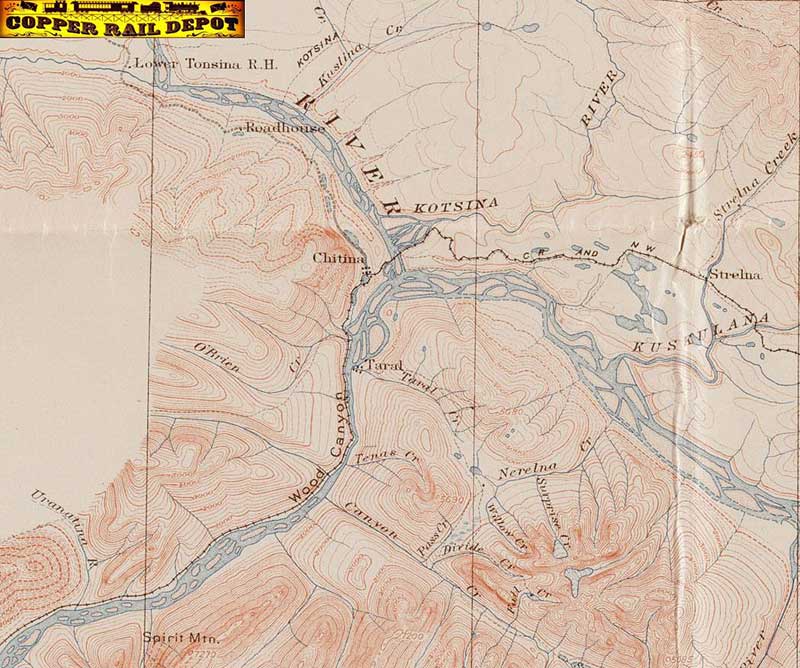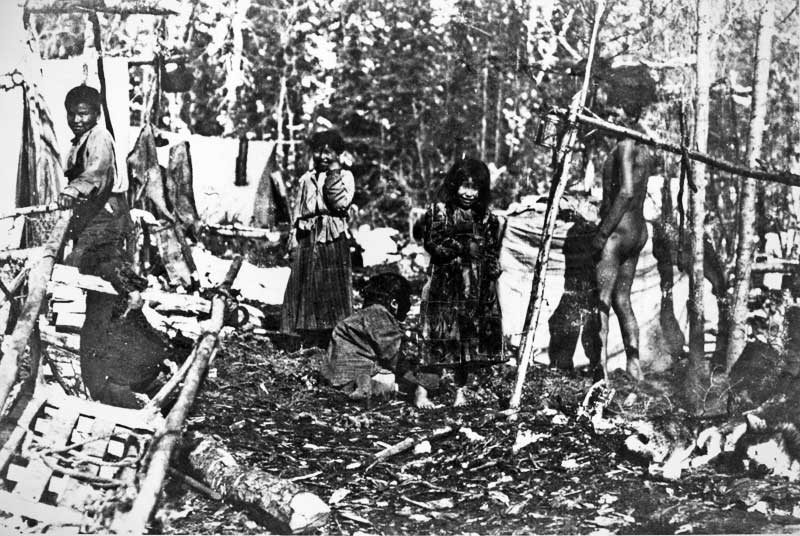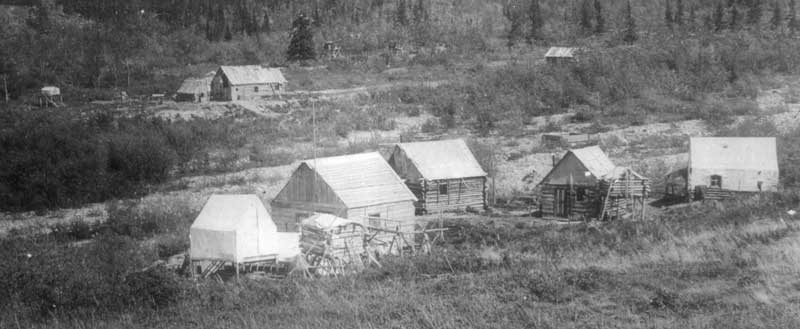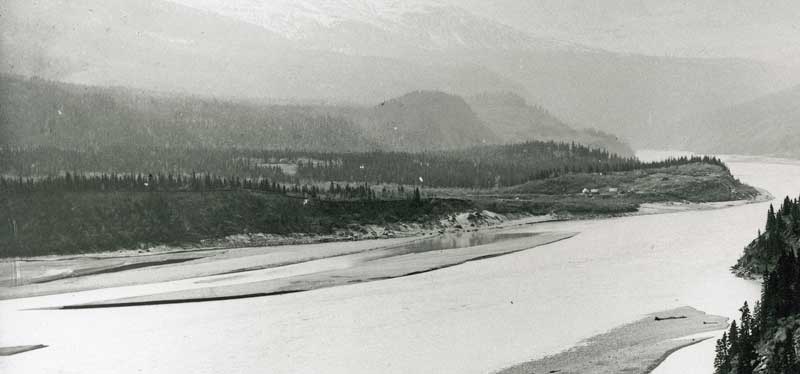Chapter 8, Pt 1:
"Sezel at Taral"
from "Legacy of the Chief"

|
Since the chief’s death so many years ago, Taral has remained abandoned,
its purposes having been served. It is no longer the lively summertime
fish camp from which forgotten generations of our people would strike
out into the rugged east country toward the vast upper lands of the
mountain glaciers to hunt the great Dall sheep and other animals which
frequented the high grounds. Although our Ahtna people were nomads,
Taral came as close to a permanent settlement as any. |
Location of Taghaelden (Taral)
on the 'Atna' tuu Ts 'itu, 1914
--UAF Archives |
The four of us sat in the sezel behind Grandfather’s
lodge house. Just behind our sezel ran the C’ena’ Taw-we-de--the source
of our fresh water. The sweathouse had a depression in the center where
hot coals over the sezel ts’ese’ had done their work. Michael reached
into the naz’aay and dipped out some of the cold creek water.
Next he adjusted the hot lava stones with the sezel cene’. The iron
tongs, like the water bucket and all of the other metal implements in
the old camp came up the river from Alaganik many years ago when
Grandfather was still young. The days of a single arduous trek in March
when the river was finally icy and snow-covered were over. Everything
now came from nearby trading posts which brought their goods up the
Richardson Trail from Valdez.
Michael was the oldest son of the oldest son of Nicolai. He was the one
who came to later be known as Captain, or Cap. He had the place of honor
next to the shee-ya--our grandfather. Michael was my skeel’eh, while
Charles was my nilth skell’eh. As the oldest of the three, I was the
soon-ga.
Michael was much more than just my cousin. He was my sla’cheen. No
English word exists which fits this type of Native relationship. White
cousins rarely live in the same proximity as is customary in our clan
society. We usually just referred to Nicolai as grandfather among
ourselves, but in his presence we called him Schee’ya as a sign of
respect and deference.
It was dark in the sweathouse except for the illumination coming from
the red-hot coals in the windowless sezel. The opening was covered with
taw-zess. The canvas was one from a pile which Nicolai obtained in a
trade with the Eyak down river years before. It held in the steam heat
much more efficiently than animal hides. The sezel was a sacred ceremony
permitted only among the males of the clan. The presence of any females
within the sezel would be en-gii, which is taboo. Nicolai was a believer
in en-gii. His entire life revolved around the spiritual world. Besides,
we were c’edeh’aede , or naked in the sezel, which is only practical in
the in a steam bath. Out of a sense of modesty alone, the females were
not present.
 |
"We stand
before Him as we were born--Ked' eh-had-eh--naked, but also
humbled. It is only fitting that we view Him in his anger
in this way. Only if we are truly humble can we hope to escape
His wrath." --Nicolai talking to his brothers and son
at his sezel in Taral upon seeing the smoke and ash burst forth
from Mt. Wrangell. |
Sezel at Taral,
circa 1900 --AMHA, Richard M. Jones, B82.5 |
Charles was eight, while we two older boys were eleven. Schee’ya invited
us to Taghaelden to listen to his Raven Story of Creation. Our overnight
visit at Taral was Nicolai’s way of introducing us into the Native
spiritual world in which Schee’ya lived. We needed to prepare ourselves.
That was one of the purposes of the sezel. He told the three of us
k’enaey to prepare the sezel so we could begin the spiritual process.
The sezel was a cleansing ritual which also served to provide a close
sense of kinship. In some sezels it was customary to talk. When just
three of us were together, we always had much to discuss. As young
Indian boys we found the world to be a marvelous place full of many
curious things. But in the presence of Nicolai, we had been warned by
Michael’s father, my oldest uncle and the man who would come to be known
as Chief Goodlataw, not to speak at all unless asked a question by
Nicolai. Grandfather did not appreciate frivolous conversation,
especially in the sezel. He considered it aimless chatter, or
woman-talk. Nicolai lived in a largely silent world of the spirits. It
was the realm of Yaabel the devil, and the c’eyuuni (we called it kay-yew-nee)
and of the c’eyuuni lede’, which had something to do with the spirit
which resided at Uk’eledi, the one with the smoke on it.
He was a solitary figure, even though he once lived with two or three
women and he had many children. Tonight we would hear him speak more
than any of us could have ever imagined. Many Ahtna stories explain our
world, they are crude and simple compared to Nicolai’s Raven Story of
Creation.
Every one of us had learned to fear Nicolai’s temper, which would appear
like an ocean squall--without warning and with animal-like ferocity.
Everyone in the family from the oldest male member down to the youngest
child feared the awesome temper of Nicolai. He had been known to banish
family members, including one of his own brothers, out of Taral for
life. Nicolai remained the undisputed chief over all of us in the area
around T’sedi-na--even though he had long since given up the title. It
did not matter who was in charge. When Nicolai spoke, no one ever dared
challenge him. Even after he died people feared him and his words. His
power was considered that great.
Much of the time Nicolai remained isolated at Taral, alone now that
Udzisyu had died. He claimed that he needed to consult with the spirits.
On rare occasion Doc Billum would boat Nicolai across the river to
Chittyna. Even then he stayed largely out of public view, usually with
his son Chief Goodlataw and later in the home which we skeel-eh rebuilt
for him and ourselves.
The three of us skeel-eh sat in nearly complete darkness, building up a
heavy sweat from the hot steaming coals. Across from us Nicolai appeared
to be in a state of trance. Charles started to speak up. I moved to
quickly to shut him up, slapping my hand over his open mouth, fearing an
angry reaction from Schee’ya. I just caught a movement from Nicolai’s
very deep, dark eyes, but he relaxed, returning back into his previous
state. Both Michael and I looked at each other in relief. Charles looked
up at me with what appeared to be a plea of forgiveness for his
unthinking transgression. I reached over and squeezed his shoulder, and
he settled back, satisfied that nothing bad would happen.
Michael continued to tend the coals and lava stones with my help.
Nicolai never said anything. Our time in the sezel remained silent. When
it was finally time to leave the sezel, Schee’ya reached over and
quietly picked up his sde’ sed ah, wrapped himself in it and stood up to
leave. I reached over to alert Charles. The three of us each took up our
own tanned-hide robes and followed Nicolai out to the creek where we
would immerse ourselves in the cold water to complete the sweathouse
ceremony. Then we returned to the front of the main lodge still wrapped
only in our sde’ to tend to the fire.
 |
The dominant
structure at Taral was a long, low log cabin, which was partly
sunken into the ground. It contained a central fire pit
and resembled the more sophisticated Tlingit community houses.
The primitive, canvas-covered building had long served as a clan
gathering place. It occupied the same spot where similar
structures had stood since well before the earliest Russian
incursions. Several lesser primitive structures faced the
larger one from across the fire pit without obstructing
Nicolai's commanding view of the river. These were small
log houses, canvas-covered pole structures, sezels, pole caches,
and summer homes that had already begun to fall down.
--Reflections of Johnny Gakona |
Detail of image of Taral with lodge in
background across the creek. --Candy
Waugaman Collection |
Nicolai sat in his place in front the lodge entrance, his back against
the lodge wall as he faced the large outdoor fire-pit. The lodge was on
a rise which overlooked the great river. Nicolai ensured he would have
that view when he built his home many years before. He could face the
fire and the magnificent Copper River at the same time. Michael, Charles
and I each tightened up our sez, which is the belt that secures the sde’
around our middle, and set about the process of building up the fire.
Everything was already in place, just as it had been in the sezel. We
needed only to take some of the coals from the sezel with the sezel cene’
and transfer them to the pile of wood which was waiting to be lit.
Michael returned to the sezel, emerging with a load hot coals. He
carefully placed them under the tsets , and the pile quickly ignited. We
tightened and adjusted the woodpile and then sat down facing Nicolai.
Michael was on this right, I on the left, with Charles sitting next to
me. Because grandfather had not yet spoken, we built the fire in
complete silence. Around us the darkness was creeping in. The sky was
clear, but the moon was not yet visible. Soon we would only be able to
see by the light provided by the fire.
Chief Nicolai stared through the fire we had been stoking up. The last
of the sun rays were departing over the tall mountains along the west
bank across the Copper River. Those fleeting rays briefly illuminated
Shee’ya’s face. Then the they passed on, overtaken by the long, dark
shadows. We could see the wooded hills above us to the east still bathed
in those last bright rays, but it was already dark and chilly on the
ground. The slowly increasing mass of flames was fueled by fresh spruce
bows and dried, newly split firewood from the huge stock which had been
built up at the old encampment over the last several seasons. A slow
roar began as the arms of the fire worked toward the top of the high
stacked pile.

|
Detail
of west bank view focusing on Taral --UAF, Julie
Sweeney 97-139-667 |
My younger brother Charlie and I, the sons of the Polish-American
railroad surveyor who had first entered our country by way of the
Klutina Glacier in 1898, were the only half-white grandsons of the great
sleep-doctor. Our mother stayed in Klaw-tee-kaw in those days when so
many of those early prospectors died making their way into the Copper
River country by a route that had been abandoned years before by our own
Ahtna people because it was so treacherous. Our father, who showed up on
the railroad company payrolls as Emil Gadanski, was one tough,
determined man. He was from among a handful of survivors who completed
the trek of 1898 to the trading post at Copper Center. The very next
year Captain Abercrombie cut the Richardson Trail from Valdez,
eliminating one of the toughest routes over the Chugach coastal range
ever conceived.
Dad came for the opportunities he saw in the Klondike gold rush. Like so
many, he never made it past the Copper River valley. He had found his
home. It may have been his rendezvous with Mom at Klaw-tee-kaa that
decided it for him. She was not inclined to venture far from the only
land she had ever known, the land of our ancestors at the base of the
Wrangell Range, though she was well-known to be a wandering soul within
the Copper River area from Eyak to Mentasta.
Both of our parents were possessed of independent spirits. It was
probably fatal to their relationship. At a deep level, they held an
unusual loyalty to each other long after Mom abandoned Dad while he
worked his mining claims at Dan Creek in 1906.
Mom was one of a large number of daughters of the great chief. He had
several sons, but few survived long enough for me to ever meet them,
except for Michael’s father Goodlataw. Maybe this was why Nicolai
treasured us grandsons so much. The three of us boys were honored to be
alone with him on the grounds where our ancestors had spent countless
summers netting thloo-ka at the place where the two great rivers meet.
|
No comments:
Post a Comment